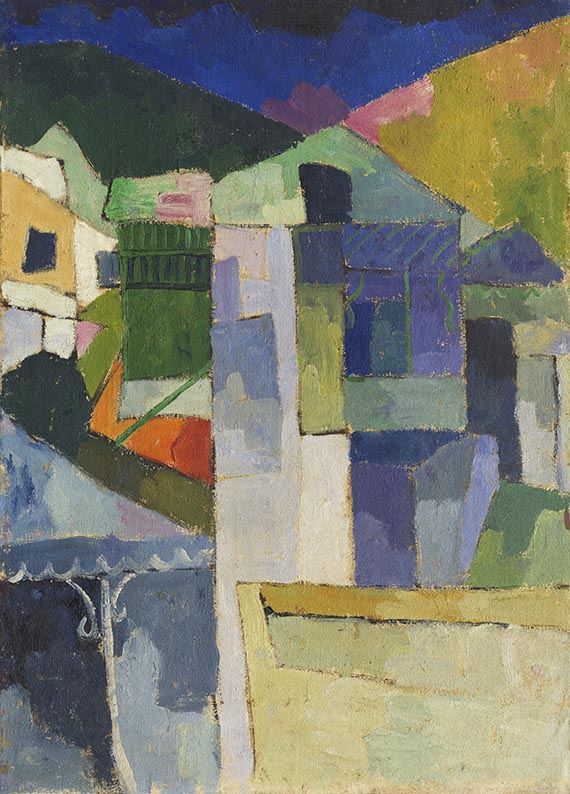Dictionary


Art Colony Schwaan
The small town of Schwaan, located between Rostock and Güstrow in the north German state of Mecklenburg, is surrounded by a landscape that is so picturesque that it must have seemed more than inviting to start an artists' colony there. Which is why it is not surprising that Otto Dörr (1831-68), Eduard Ehrke (1837-84) and Carl Malchin (1838-1923) chose to depict the Schwaan environs as early as around 1860.
However, the actual painters' colony Schwaan was founded by a local: Franz Bunke (1857-1939), who had been educated at the Weimar Malerschule, where he also taught as of 1886, spent the summer months in his hometown as of 1892. His students and colleagues from Weimar would soon follow him, among them were Paul Baum, Arno Metzeroth, Paul Riss, Rudolf Holzschuh, Alfred Heinsohn and Richard Starcke. The two Schwaan natives Peter Paul Draewing and Rudolf Bartels, the latter would soon be on the brink to Expressionism, also count among the artists' colony's members and were taught by Franz Bunke.
Just as all other members of the Schwaan artists' colony, they had also studied in Weimar, where Theodor Hagen had successfully introduced en plein air painting after the model of the School of Barbizon. This way of painting was therefore preferred, however, the group activities of the Schwaan paintings did not inevitably lead to a common style.
The popularity of the Schwaan artists' colony reached its height with an exhibition in the Rostock Museum in 1904, but World War I would soon put an end to the painters' colony.
The small town of Schwaan, located between Rostock and Güstrow in the north German state of Mecklenburg, is surrounded by a landscape that is so picturesque that it must have seemed more than inviting to start an artists' colony there. Which is why it is not surprising that Otto Dörr (1831-68), Eduard Ehrke (1837-84) and Carl Malchin (1838-1923) chose to depict the Schwaan environs as early as around 1860.
However, the actual painters' colony Schwaan was founded by a local: Franz Bunke (1857-1939), who had been educated at the Weimar Malerschule, where he also taught as of 1886, spent the summer months in his hometown as of 1892. His students and colleagues from Weimar would soon follow him, among them were Paul Baum, Arno Metzeroth, Paul Riss, Rudolf Holzschuh, Alfred Heinsohn and Richard Starcke. The two Schwaan natives Peter Paul Draewing and Rudolf Bartels, the latter would soon be on the brink to Expressionism, also count among the artists' colony's members and were taught by Franz Bunke.
Just as all other members of the Schwaan artists' colony, they had also studied in Weimar, where Theodor Hagen had successfully introduced en plein air painting after the model of the School of Barbizon. This way of painting was therefore preferred, however, the group activities of the Schwaan paintings did not inevitably lead to a common style.
The popularity of the Schwaan artists' colony reached its height with an exhibition in the Rostock Museum in 1904, but World War I would soon put an end to the painters' colony.
Offers
Headquarters
Joseph-Wild-Str. 18
81829 Munich
Phone: +49 89 55 244-0
Fax: +49 89 55 244-177
info@kettererkunst.de
Louisa von Saucken / Undine Schleifer
Holstenwall 5
20355 Hamburg
Phone: +49 40 37 49 61-0
Fax: +49 40 37 49 61-66
infohamburg@kettererkunst.de
Dr. Simone Wiechers / Nane Schlage
Fasanenstr. 70
10719 Berlin
Phone: +49 30 88 67 53-63
Fax: +49 30 88 67 56-43
infoberlin@kettererkunst.de
Cordula Lichtenberg
Gertrudenstraße 24-28
50667 Cologne
Phone: +49 221 510 908-15
infokoeln@kettererkunst.de
Hessen
Rhineland-Palatinate
Miriam Heß
Phone: +49 62 21 58 80-038
Fax: +49 62 21 58 80-595
infoheidelberg@kettererkunst.de
We will inform you in time.




